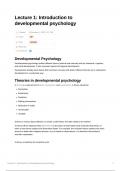developmental psychology
Created @January 9, 2023 3:27 PM
Class DP
Type Lecture
Materials
Reviewed
Developmental Psychology
Developmental psychology studies different factors (internal and external) and the emotional, cognitive,
and social development. It also compares typical and atypical development.
Development already starts before birth and does not stop until death. Different theories try to understand
development in a systematic way.
Theories in developmental psychology
A theory is a coherent set of ideas, hypotheses, and explanations. A theory should be:
Descriptive
Explanatory
Predictive
Making assumptions
Reduction of reality
Generizable
Testable
Science is not just data collection, to create a valid theory, the data needs to be ordered.
A theory will be replaced when it is falsified on the basis of observations that contradict that theory, or
when a new theory explains the observation better. For example, the evolution theory explains the world
around us better than religious theories, as it is based on observations. It is therefore the preferred
scientific explanation.
A theory is tested by the empirical cycle.
Lecture 1: Introduction to developmental psychology 1
, Minor theories are theories about a single phenomenon (EX the development of depth perception)
Major theories explain broad phenomena (EX the development of cognition)
A good developmental theory:
Relates to ontogeny (= the development of an individual from the earliest stage to maturuty)
Focuses on change over time
Explains the emergence of new properties
Is preferably useful in education / interventions
Dimensions in developmental theories
1. Nature versus nurture
Nature (endogenous)
Knowledge is innate and gets expressed during the course of development
Nurture (exogenous)
Only learning mechanisms are innate, all the rest of development is determined by the
environment. There is no knowledge at the start.
Combination of both
Both innate predispositions and the environment shape development
2. Continuous versus stages
Lecture 1: Introduction to developmental psychology 2
, Continuous
Development is gradual and children are not qualitatively different from adults, they just lack
experience. A child just needs to gain experience to become an adult.
Stages (step-wise)
Children are qualitatively different from adults. Development occurs in transitions.
Combination of both
Development is gradual but some behaviours dominate temporarily. That is why development
appears to occur stagewise.
3. Passive versus active
Passive
The child is a consumer of the information from the environment and plays a passive role in their
development. They absorb offered information. According to the theory development occurs
automatically.
Active
The child plays a more active role in its own development. It constructs its own knowledge and
looks for information by itself.
Combination of both
Some processes develop automatically but other processes need an active role of the child.
Motor development
Milestones motor development: sequence is the same for everybody, the individual differences are in
timing, but not in the order of development.
Maturational theory of Gesell (1924)
Motor development is mostly determined by biological processes. Maturation is biologically directed:
everyone shows the same developmental patterns independent of the environmental input.
Key points of Gesell maturational theory:
Maturation of the central nervous system determines the development of the child. Behavioural
development follows CNS development.
Cephalocaudal trend: development goes from head to foot.
Proximodistal trend: development goes from the centre of the body to the periphery
Differences in a child’s temperament play an important role in the pace of development.
The role of the parents is to provide the right environment. No pushing the child and doing things
when the child is ready.
Criticism:
Not all children follow the same pattern of development (EX backward crawling and butt sliding)
The theory does not generalize to all cultures
The environment plays a guiding role in development (McGraw)
Lecture 1: Introduction to developmental psychology 3
, McGraw (1945)
The environment can shape motor development. They found this during a twin study (Jimmy and Johnny
Woods). One twin received special training in swimming, skating, and climbing. This caused his
development to accelerate. The extra training did not change the pattern of development.
Dynamic systems theory (DST)
Development is a complex interaction between properties of the system and environment.
A system is a collection of components that are interrelated (EX a body, a family, a floc of birds)
A dynamic system is a collection of changing components that influence each other which describes
how a state changes into another state over time.
An important property is self-organisation. The effects are non-linear: small changes in one variable may
bring qualitative changes in the whole pattern. One small change can create a lot of new possibilities.
Esther Thelen (1941-2004) created the dynamic systems theory of motor development. According to the
theory, motor development is shaped by:
Development of the central nervous system (nature)
Development of motor skills (nature)
Environment (context and task)
Development is shaped by nature, but the environment is neccesary as well. Instead of McGraw, she
believed that physical properties and the environment influence action. In turn, the action influences
environmental changes and physical properties, which then influenece the actions again.
Lecture 1: Introduction to developmental psychology 4











